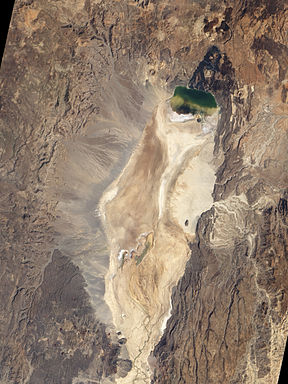Suguta Valley
| Suguta Valley | |
|---|---|

Satellite view of the valley. Namarunu in lower left, Lake Logipi towards the upper right.
|
|
| Floor elevation | 300 m (980 ft) |
| Geography | |
| Coordinates | 2°05′28″N 36°30′49″E / 2.091058°N 36.513748°ECoordinates: 2°05′28″N 36°30′49″E / 2.091058°N 36.513748°E |
The Suguta Valley, also known as the Suguta Mud Flats, is an arid part of the Great Rift Valley in Kenya (Africa), directly south of Lake Turkana.
The Suguta valley today is one of the driest parts of Kenya, with annual rainfall below 300 millimetres (12 in). Lake Logipi seasonally fills a small part of the northern end of the valley. The valley has a relatively flat floor about 300 metres (980 ft) above sea level. It is bordered by land to the east and west rising to 1,000 metres (3,300 ft) and dotted with volcanic cinder cones. The Barrier Volcano, a broad volcanic complex, separates the valley from Lake Turkana.Mount Ngiro rises to the east of the Suguta valley. The Losiolo Escarpment, rising 2,000 metres (6,600 ft) above the valley floor on the east side near Maralal provides one of the most dramatic views of the Kenyan rift valley.Namarunu, a volcano active in historic times, extends into the valley from the western wall.
The Suguta Valley lies along the axis of the Gregory Rift, which has been faulting in this area since the Pliocene along a belt 35 kilometres (22 mi) wide. The belt lies between the Ngiro basement uplift to the east and the Loriu Plateau to the west, and is thicker in the eastern part. Exposed volcanic rocks include basalts, tuffs and ash formed between 4.2 and 3.8 million years ago, the products of trachytic volcanism from 3,8 to 2.6 million years ago and basaltic and alkali basaltic rocks created from that period until the present. In the early Pliocene the least horizontal stress direction - the direction of rift expansion - was NW-SE.
Lake Suguta once filled the valley, at times overflowing into Lake Turkana. The lake level rose and fell several times in the last 18,000 years due to changes of rainfall during the African Humid Period that lasted from 14,800 to 5,500 years ago. The lake level began to drop about 8,000 years ago, falling by 250 metres (820 ft).
...
Wikipedia

